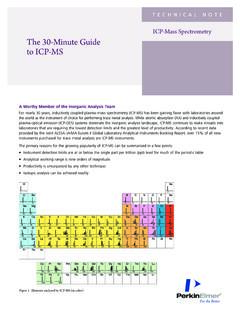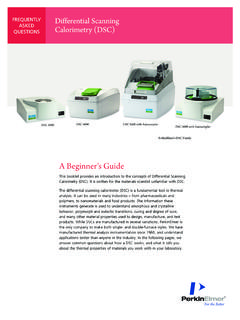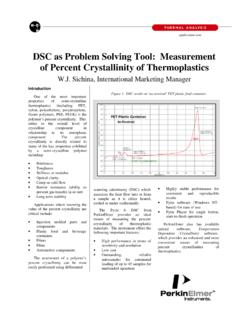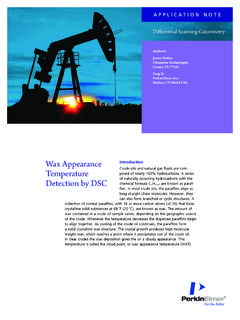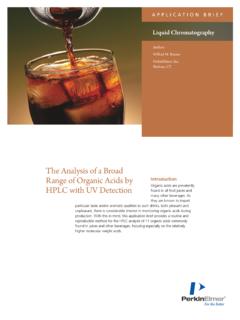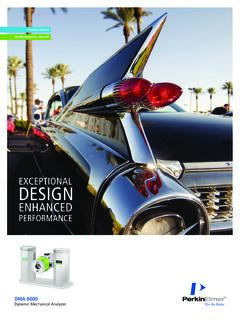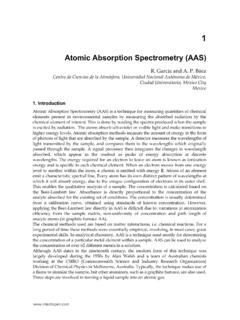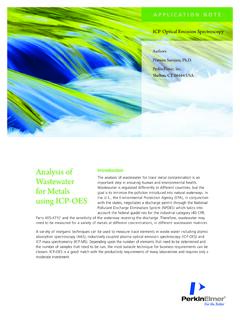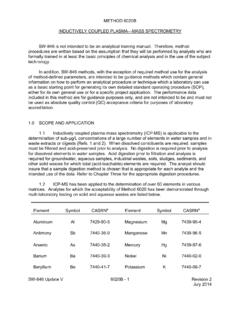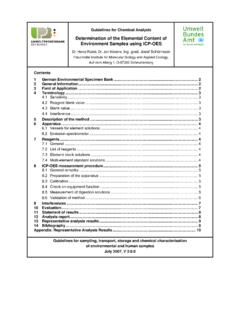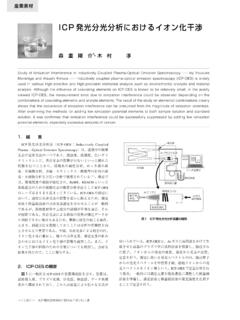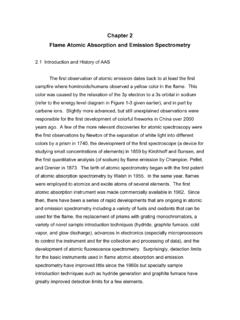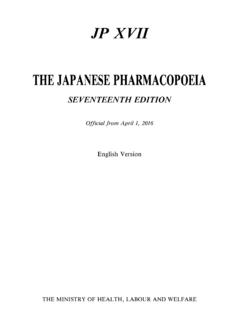Transcription of The 30-Minute Guide to ICP-MS - PerkinElmer
1 Technical noTeICP-Mass SpectrometryThe 30-Minute Guide to ICP-MSA Worthy Member of the Inorganic Analysis TeamFor nearly 30 years, inductively coupled plasma mass spectrometry ( ICP-MS ) has been gaining favor with laboratories around the world as the instrument of choice for performing trace metal analysis. While atomic absorption (AA) and inductively coupled plasma - optical emission (ICP-OES) systems dominate the inorganic analysis landscape, ICP-MS continues to make inroads into laboratories that are requiring the lowest detection limits and the greatest level of productivity. According to recent data provided by the Joint ALSSA-JAIMA-Eurom II Global Laboratory Analytical Instruments Booking Report, over 15% of all new instruments purchased for trace metal analysis are ICP-MS instruments. The primary reasons for the growing popularity of ICP-MS can be summarized in a few points: Instrument detection limits are at or below the single part per trillion (ppt) level for much of the periodic table Analytical working range is nine orders of magnitude Productivity is unsurpassed by any other technique Isotopic analysis can be achieved readilyFigure 1.
2 Elements analyzed by ICP-MS (in color).2graph for each element. The bars depict the number and relative abundance of the natural isotopes for that element, which is sometimes referred to as the isotopic fingerprint of the element. If you noticed, earlier in this paragraph, the word typically was used because there is an element that does not follow the natural abundance rule: lead (Pb). Naturally occurring lead originates from two sources some was placed here when the earth was born and some is the result of the decay of radioactive materials. This creates a situation where the lead isotope ratios may vary depending on the source of the lead. To be sure that we accurately measure the concentration of lead in a sample, it is necessary to sum several of the isotopes available. ICP-MS can be used to measure the individual isotopes of each element; this capability brings value to laboratories interested in one specific isotope of an element or in the ratio between two isotopes of an quick overviewAn ICP-MS consists of the following components: Sample introduction system composed of a nebulizer and spray chamber and provides the means of getting samples into the instrument ICP torch and RF coil generates the argon plasma , which serves as the ion source of the ICP-MS Interface links the atmospheric pressure ICP ion source to the high vacuum mass spectrometer Vacuum system provides high vacuum for ion optics, quadrupole, and detector Collision/reaction cell precedes the mass spectrometer and is used to remove interferences that can degrade the detection limits achieved.
3 It is possible to have a cell that can be used both in the collision cell and reaction cell modes, which is referred to as a universal cell Ion optics guides the desired ions into the quadrupole while assuring that neutral species and photons are discarded from the ion beam Mass spectrometer acts as a mass filter to sort ions by their mass-to-charge ratio (m/z) Detector counts individual ions exiting the quadrupole Data handling and system controller controls all aspects of instrument control and data handling to obtain final concentration it is time to take a closer look at each of these can be measured with an ICP-MS ?The ICP-MS instrument measures most of the elements in the periodic table. The elements shown in color in Figure 1 can be analyzed by ICP-MS with detection limitsa at or below the pptb range. Elements that are in white are either not measurable by ICP-MS (the upper right-hand side) or do not have naturally occurring analyses performed on ICP-MS instrumentation are quantitative; however, it also can serve as an excellent semi-quantitative instrument.
4 By using a semi-quantitative software package, an unknown sample can be analyzed for 80 elements in three minutes, providing semi-quantitative data that is typically within 30% of the quantitative values. For reasons that often involve human health, knowing the isotopic composition of a sample can be highly important. Of the three techniques mentioned to this point, only ICP-MS is used routinely for determining isotopic composition. How does ICP-MS work?Before getting into the individual components of an ICP-MS instrument, let s take a minute to understand the overall science of the are introduced into an argon plasma as aerosol droplets. The plasma dries the aerosol, dissociates the mol-ecules, and then removes an electron from the components, thereby forming singly-charged ions, which are directed into a mass filtering device known as the mass spectrometer. Most commercial ICP-MS systems employ a quadrupole mass spectrometer which rapidly scans the mass range. At any given time, only one mass-to-charge ratio will be allowed to pass through the mass spectrometer from the entrance to the exit.
5 If, for example, the quadrupole was set to allow ions with a mass to charge ratio of 23/1 to pass through, we would find that sodium (Na) ions would, while all other singly charged ions would not. Upon exiting the mass spectrometer, ions strike the first dynode of an electron multiplier, which serves as a detector. The impact of the ions releases a cascade of electrons, which are amplified until they become a measureable pulse. The software compares the intensities of the measured pulses to those from standards, which make up the calibration curve, to determine the concentration of the element. For each element measured, it is typically necessary to measure just one isotope, since the ratio of the isotopes, or natural abundance, is fixed in nature. It may be helpful to refer again to Figure 1 where you will see a simple bar a The detection limits are based on a 98% confidence level (3 standard deviations).b Identifying a single ppt of an element in a solution analogous to locating a single white raisin in a house (2700 sq.)
6 Ft. or 260 square meters) full of regular their voyage into the plasma , the liquid droplets, containing the sample matrix and the elements to be deter-mined, are dried to a solid and then heated to a gas. As the atoms continue their travel through the plasma , they absorb more energy and eventually release one electron to form singly charged ions. The singly charged ions exit the plasma and enter the interface interface sampling ionsPlacing a plasma , operating at 6000 C, near an ion focusing device operating near room temperature is a bit like placing the earth about a half-mile away from the sun. In addition to a large temperature difference, the plasma operates at a pressure that is much higher than the vacuum required by the ion lens and mass spectrometer portions of the interface allows the plasma and the ion lens system to coexist and the ions generated by the plasma to pass into the ion lens region. The interface consists of two or three inverted funnel-like devices called recently, all commercially available ICP-MS systems used the two-cone design.
7 Such a design requires down-stream focusing of the beam that exits the interface region. This focusing has been achieved through the use of a single or a series of charged devices called ion lenses. The need for these ion lenses can be explained in Figure 2. As mentioned earlier, the plasma (located to the left of the sampler cone) operates at atmospheric pressure, while the filtering quadrupole (located to the right of the skimmer cone) operates at a very low pressure. With a two-cone design, there can only be a two-step reduction in the pressure between the plasma and filtering quadrupole. With a two-step pressure reduction, the ion beam under-goes substantial divergence as it exits the second cone, thus requiring additional focusing if the ion beam is to properly enter the filtering introduction making the right sized dropletsAs mentioned earlier, most samples introduced into an ICP-MS system are liquids. It is necessary to break the liquid sample into small droplets before they can be introduced into the argon plasma .
8 The liquid sample may be introduced by a peristaltic pump or through self aspiration to a nebulizer that creates an aerosol of fine droplets. The type of nebulizer used can depend upon the viscosity, cleanliness, and even the available volume of the sample to be analyzed. Some of the more commonly used nebulizers used with ICP-MS systems include: Concentric Cross-flow BabingtonWithin these three general categories of nebulizers, there exist a number of variations on the general design, so it is likely that you will encounter nebulizers identified as V-Groove, GemCone , HEN (High Efficiency Nebulizer), MCN (Micro Concentric Nebulizer), etc. Each of these specialty nebulizers can enhance the introduction of specific sample types leading to overall improved performance of the fine droplets created by the nebulizer will most often be passed through a spray chamber before they are allowed to enter the plasma . Most commercially provided spray chambers fall into two categories: Scott CyclonicOnce again, we will see many variations on the theme, with spray chambers manufactured from polymers, glass, and quartz.
9 Also, spray chambers can be baffled, cooled or contain desolvation devices to improve their action. Regardless of the design, the desired end result is to allow a substantial number of the small droplets created by the nebulizer to enter the torch while discarding the larger droplets which can create analytical issues if allowed to enter the ICP torch making ionsThe plasma generated in the ICP torch creates a very hot zone that serves a variety of functions. At a temperature of approximately 6000 C, the plasma is about 10 times hotter than a pizza oven, three times hotter than a welding torch, and equal to the temperature at the surface of the sun. The plasma is generated by passing argon through a series of concentric quartz tubes (the ICP torch) that are wrapped at one end by a radio frequency (RF) coil. Energy supplied to the coil by the RF generator couples with the argon to produce the 2. The two-cone design on the left shows a wide ion beam divergence resulting from a single, large pressure reduction.
10 The three-cone design on the right shows a small ion beam divergence, resulting from two small pressure deflection device separating ions from neutrals and photonsThe ion beam exiting the interface region of the instrument contains some non-ionized materials neutrals and photons. It is necessary that the analyte ions be separated from the neutrals and photons if high performance is to be achieved. Neutrals can collect on sensitive components of the instru-ment creating drift. Photons that reach the detector can be erroneously counted as ions, which increases background and degrades detection , the device used to separate the analyte ions from the neutrals and photons should be mechanically simple, stable over a long period of time, and require little or no main-tenance. A quadrupole is typically used as a mass-filtering device, where the ions travel in a path parallel to the rods. It has been discovered that great utility can be gained if the ion beam is allowed to pass at a right angle (perpendicular) to the rods.
